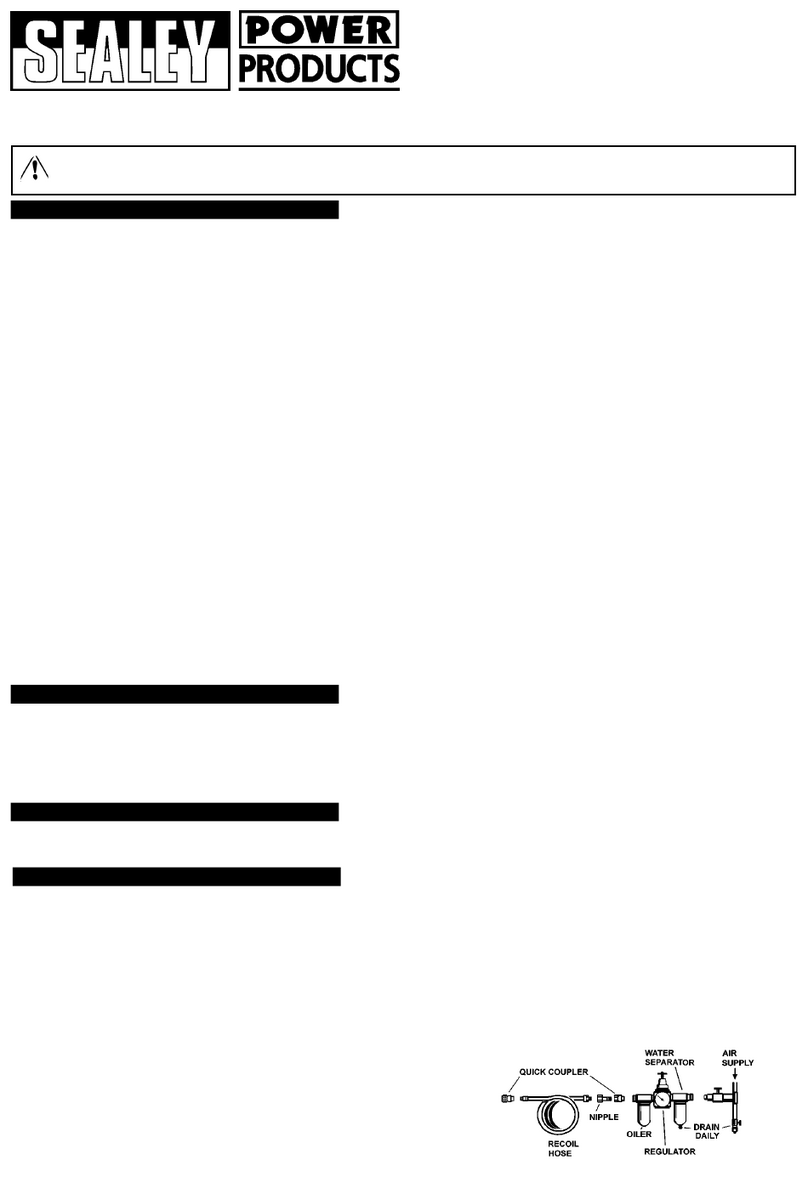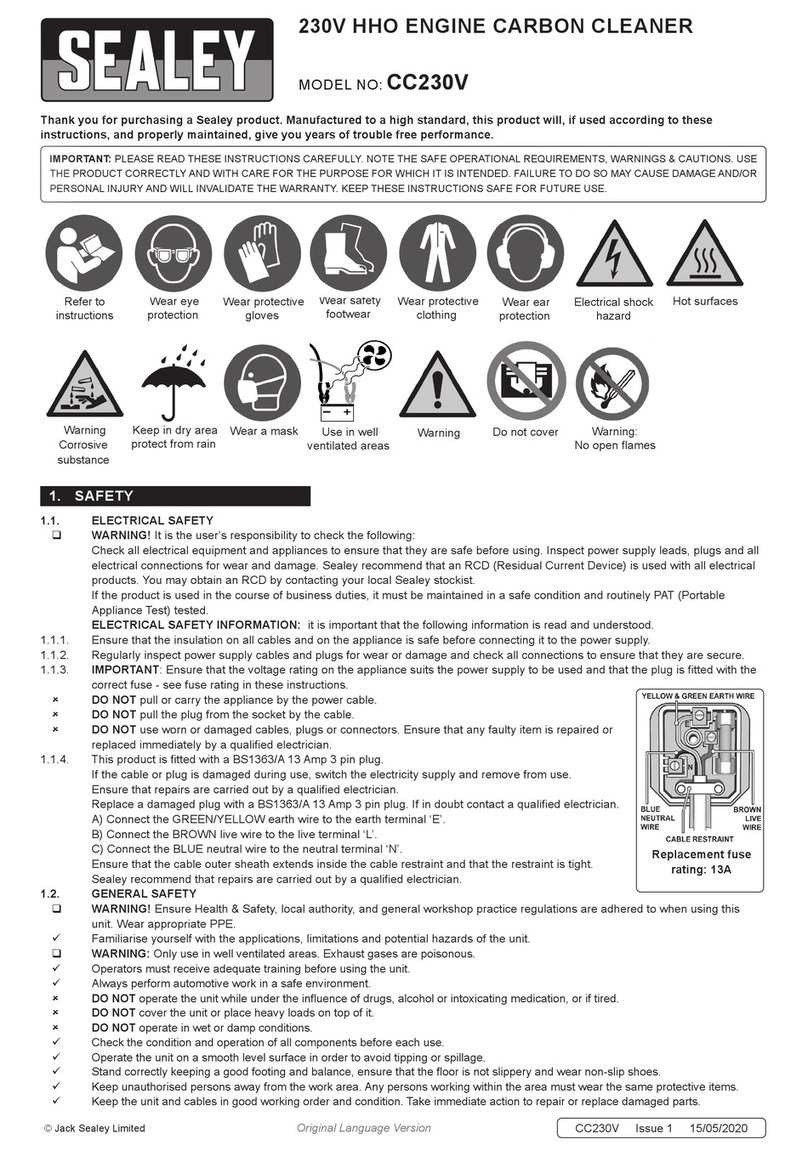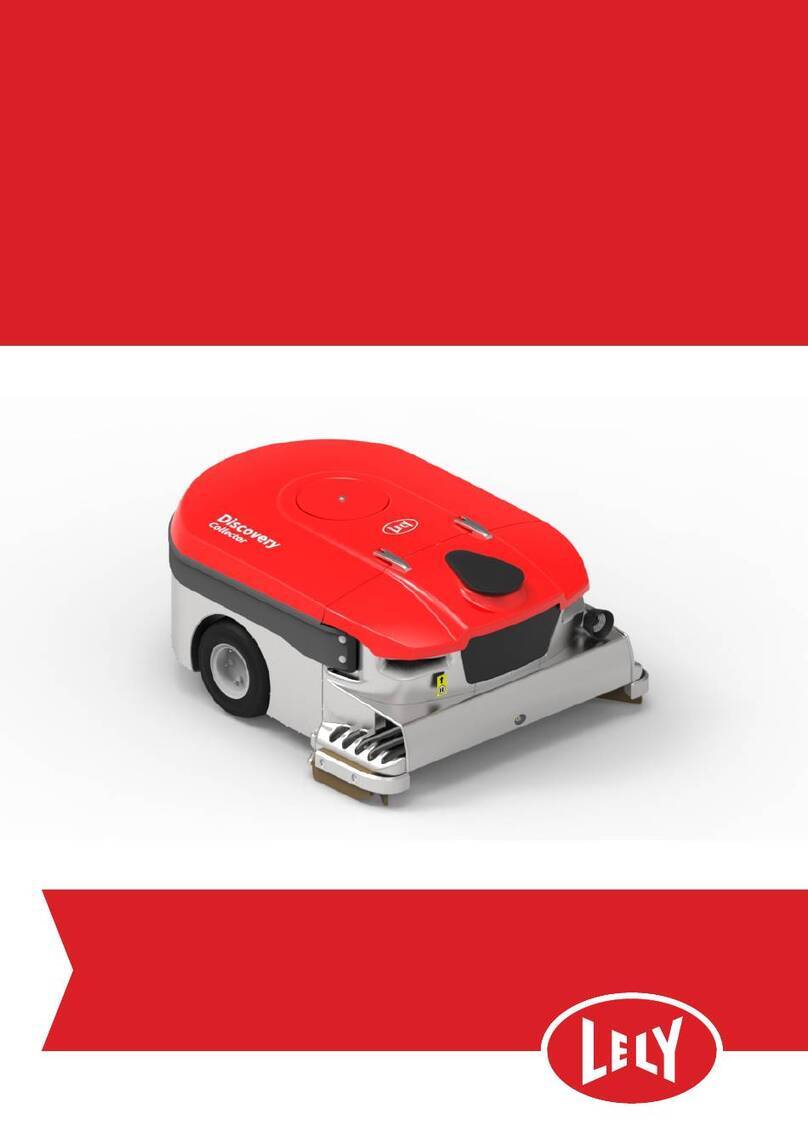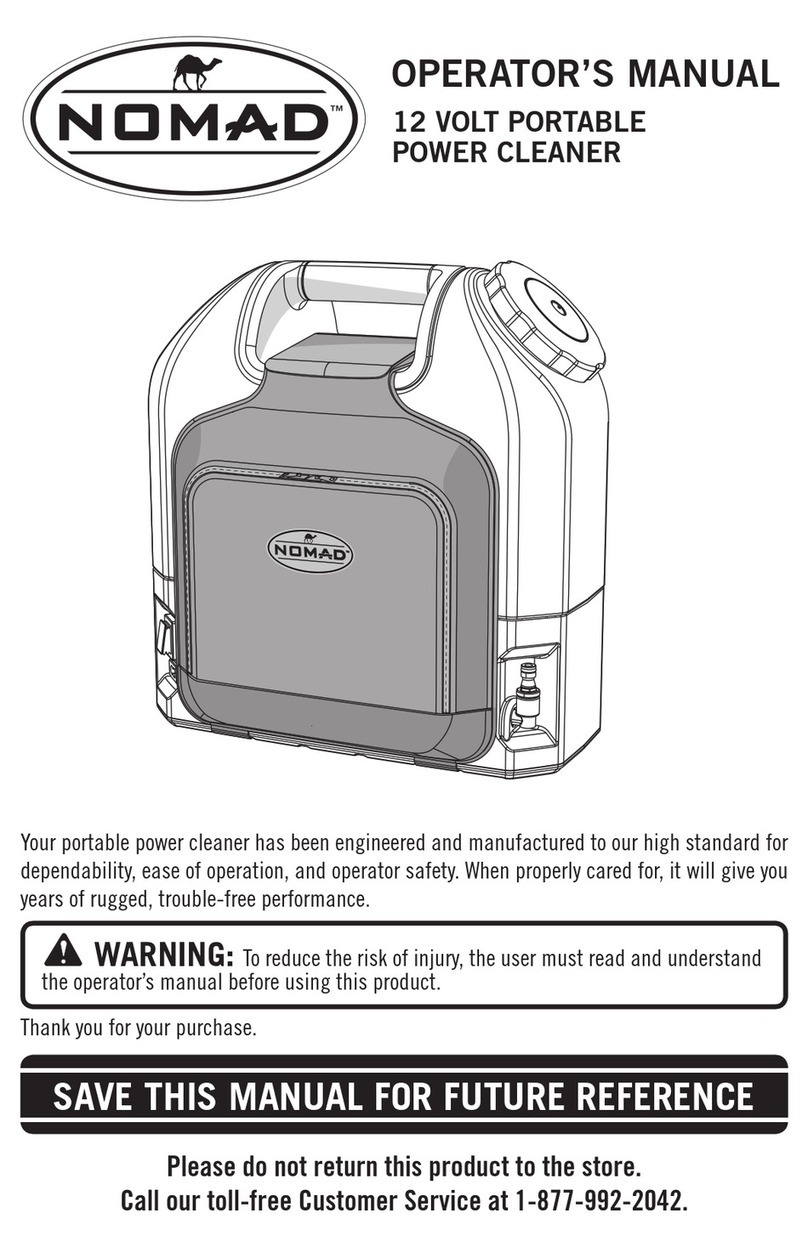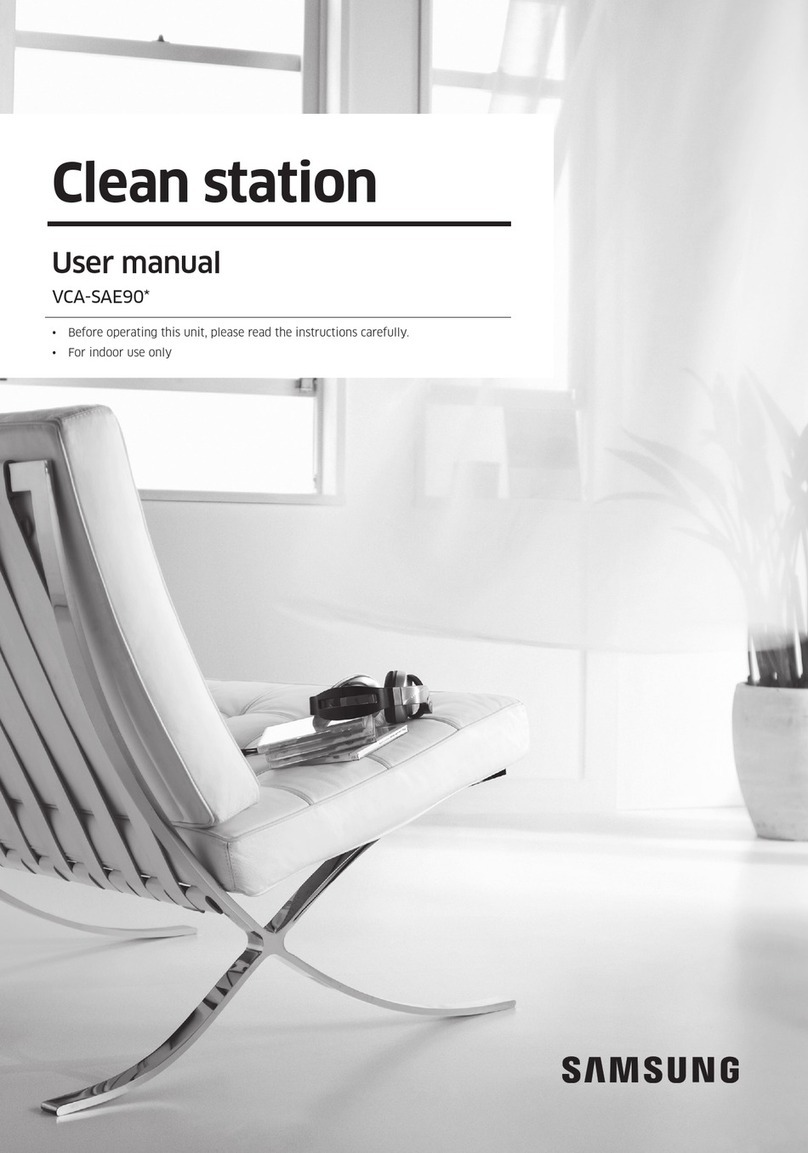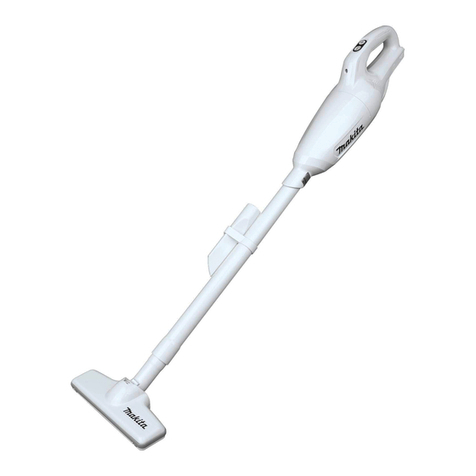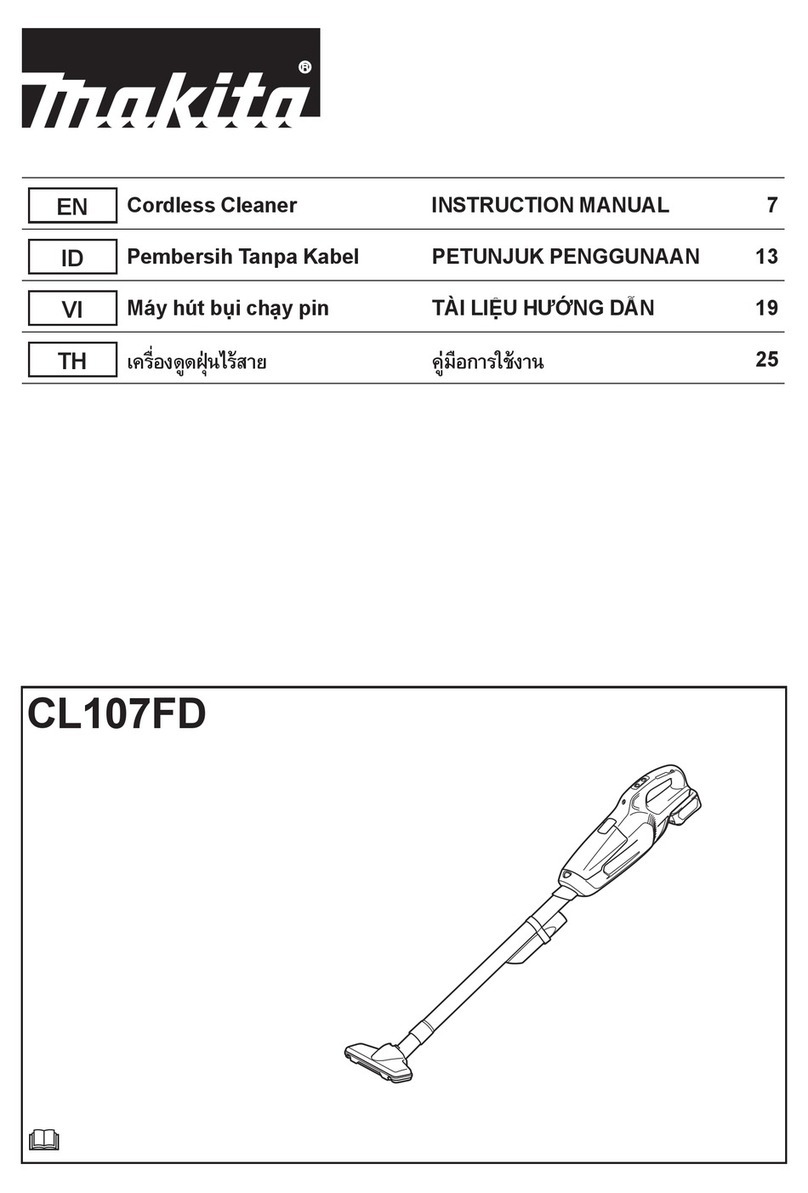Sealey VS2000 User manual

The recommended hook-up is shown below.
3.1. Ensure the air valve is in the "Off" position before connecting to the air supply.
WARNING! Ensure the air supply is clean and does not exceed pressures specified
in these Instructions. Too high an air pressure and/or unclean air will shorten
the drainer life due to excessive wear, and may be dangerous, causing
damage and/or personal injury.
3.2. Drain the compressor air tank daily and clean the air inlet filter weekly.
3.3. Line pressure should be increased to compensate for unusually long air
hoses (over 8 metres). The minimum hose diameter should be 10mm I.D.
and fittings must have the same inside dimensions.
3.4. Keep hoses away from heat, oil and sharp edges.Check hoses for
wear and make certain that all connections are secure.
INSTRUCTIONS FOR:
BRAKE DISC & LINING CLEANER 15LTR
MODEL No: VS2000
Thank you for purchasing a Sealey product. Manufactured to a high standard this product will, if used according to these instructions
and properly maintained, give you years of trouble free performance.
1. SAFETY INSTRUCTIONS
IMPORTANT: PLEASE READ THESE INSTRUCTIONS CAREFULLY. NOTE THE SAFE OPERATIONAL REQUIREMENTS, WARNINGS AND
CAUTIONS. USE THE PRODUCT CORRECTLY AND WITH CARE FOR THE PURPOSE FOR WHICH IT IS INTENDED. FAILURE TO DO SO MAY
CAUSE DAMAGE AND/OR PERSONAL INJURY AND WILL INVALIDATE THE WARRANTY. PLEASE KEEP INSTRUCTIONS SAFE FOR FUTURE USE.
2. INTRODUCTION AND ASSEMBLY
2.1. Introduction
Reduce the chances of brake dust getting airborne and help protect you and your workforce from the effects of brake dust inhalation.
Air operated brake cleaner device can be used remotely from air supply and the recycling function prolongs the life of the brake
cleaning fluid. Cranked neck makes this unit suitable for use under lift or next to ramps. Fitted with four large castor wheels, two
braked, for workshop mobility. Suitable for use with Sealey Brake Cleaning Solvent or other proprietary brands. Supplied with cleaning
brush.
2.2. Contents
2.2.1. Check the contents against the following list. If any items are damaged or missing contact your
supplier immediately.
•TankAssembly•SmallDrainPan•LargeDrainPan•DrainPanPipe•BrushandHose
•DrainPanMat
2.3. Assembly
2.3.1. Screw the small drain pan onto the threaded end of the drain pan pipe.
2.3.2. Insert other end of drain pan pipe (fig. 1.A) into the top tank fitting (fig. 1.D), as far as the spring
ring (fig. 1.B). Tighten the pipe clamp screw (fig. 1.C).
3. AIR SUPPLY
1.1. GENERAL SAFETY
WARNING! Ensure Health & Safety, local authority and general workshop practice regulations are adhered
to when using this equipment.
Familiarise yourself with the application, limitations and hazards of the cleaner.
WARNING!Disconnect the cleaner from the air supply before changing accessories, servicing or performing any maintenance.
Maintain the cleaner in good condition (use an authorised service agent).
Replace or repair damaged parts. Use genuine parts only. Unauthorised parts may be dangerous and will invalidate the warranty.
Keep the work area clean, uncluttered and ensure that there is adequate lighting.
Keep the cleaner clean for best and safest performance.
Maintain correct balance and footing. Ensure that the floor is not slippery and wear non-slip shoes.
Keep children and unauthorised persons away from the work area.
WARNING! Ensure that correct air pressure is maintained and not exceeded.
Keep air hose away from heat, oil and sharp edges. Check air hose for wear before each use and ensure that all
connections are secure.
DO NOT use the cleaner for any purpose other than that for which it is designed.
DO NOT operate the cleaner if any parts are damaged or missing as this may cause failure and/or personal injury.
DO NOT stand on the cleaner.
DO NOT adjust or tamper with the safety valve.
DO NOT move the cleaner by the hose, or yank the hose from the air supply.
DO NOT place attachments close to your face (especially eyes, ears, etc.) and do not point hose at other
persons or animals.
DO NOT allow untrained persons to operate the cleaner.
DO NOT operate the cleaner when you are tired or under the influence of alcohol, drugs or intoxicating medication.
DO NOT leave the cleaner operating unattended.
DO NOT direct air from the air hose at yourself or others.
When not in use disconnect from the air supply, vent reservoir and store in a safe, dry, childproof area.
Dispose of waste fluid in accordance with local authority regulations.
WARNING! DO NOT pollute the environment by allowing uncontrolled discharge of waste.
g.1
Original Language Version VS2000 Issue: 3 - 20/04/12

4. OPERATION
WARNING! Ensure that you read, understand and apply the safety instructions in Section 1.
4.1. Filling.
4.1.1. Open the pressure relief valve to ensure that there is no pressure in the lower tank (there is a valve between the upper and lower
tanks which is closed when the lower tank is pressurized and open when it is not).
4.1.2. Fill the lower tank with Brake Cleaning Solvent by pouring it into the drain pan, from where it will run through the upper tank into the
lower tank. Check solvent level in sight tube. Approximate fill volume is 15 litres.
4.2. Operation.
4.2.1. Positionthecleanerpan(largeorsmalltosuitapplication)underthebrakeassemblyandtightenthepipeclampscrew.
4.2.2. Connect the brush hose to either the direct or impulse outlet, as required.
4.2.3. Check that the inlet valve and relief valves are closed and then connect an air line to the air inlet. Supply pressure should not exceed
90psi.
4.2.4. Turn on the air supply, open the inlet valve and adjust the pressure regulator to give a suitable solvent flow from the brush (typically
1 to 2 bar). DO NOT exceed 90psi (6 bar).
4.2.5. Carry out the cleaning operation. The dirty fluid will flow from the pan into the upper tank. The valve between the tanks will prevent the
fluid from entering the lower tank until the lower tank pressure is vented.
4.2.6. When cleaning is finished, close the air inlet valve and open the relief valve. The used fluid in the upper tank will now flow into the
lower tank, passing through the upper tank filter.
Note: If necessary the unit can be operated disconnected from the air supply - once the lower tank has been pressurized close the inlet
valve and disconnect the air supply. The cleaner will now operate as normal until the pressure in the lower tank falls too low to provide
an adequate solvent flow.
4.3. Emptying.
WARNING! Ensure that the cleaner is disconnected from the air supply and that the
relief valve is open.
4.3.1. Placeasuitablecontainerunderthelowertankandthenremovethedrainplug.
4.3.2. When the tank is drained replace the drain plug.
IMPORTANT! Dispose of waste solvent in accordance with local authority regulations.
4.4. Filter.
Regularly remove and clean the upper tank filter.
4.4.1. Remove drain pipe from upper tank cover.
4.4.2. Open the four cover retaining clips and remove the cover.
4.4.3. Lift out the filter and clean with soapy water. Thoroughly rinse and dry.
4.4.4. Install the cleaned dry filter, replace and clip down the cover and refit the drain pipe.
NOTE: It is our policy to continually improve products and as such we reserve the right to alter data, specifications and component parts without prior notice.
IMPORTANT: No liability is accepted for incorrect use of this product.
WARRANTY: Guarantee is 12 months from purchase date, proof of which will be required for any claim.
INFORMATION: For a copy of our latest catalogue and promotions call us on 01284 757525 and leave your full name and address, including postcode.
Sole UK Distributor, Sealey Group,
KempsonWay,SuffolkBusinessPark,
Bury St. Edmunds, Suffolk,
IP327AR
Original Language Version VS2000 Issue: 3 - 20/04/12
01284 757500
01284 703534
sales@sealey.co.uk
www.sealey.co.uk
Web
email
Parts support is available for this product. To obtain a parts listing and/or diagram, please log on to www.sealey.co.uk, email
sales@sealey.co.uk or phone 01284 757500.
Table of contents
Other Sealey Ultrasonic Jewelry Cleaner manuals
